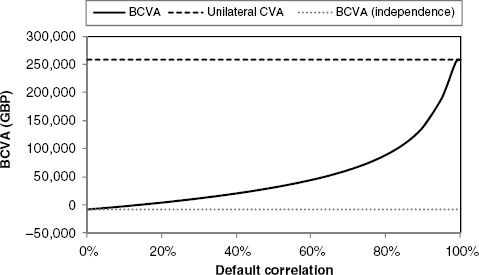13.4 Further DVA Considerations
13.4.1 Impact of Default Correlation
We consider next the impact of dependence between the default events of the institution and their counterparty. The most common way to correlate defaults is via the Gaussian copula approach attributed to Li (2000) and mentioned in the last chapter. A simple way to do this in the current case is given by Gregory (2009a). We show the impact of correlation in Figure 13.2. The impact is very strong, with the benefit of the overall negative BCVA lost at only a small correlation value (around 14%). Thereafter, the BCVA increases towards the unilateral value as the correlation between the default times increases to 100%. This is due to a fairly well-known feature of the Gaussian copula approach where at 100% correlation the default times are co-monotonic and where the most risky name is certain to default first and therefore the DVA benefit is lost.
Figure 13.2 BCVA as a function of the correlation between the default times of the institution and their counterparty.

The above approach is not the only way to introduce dependency between default events. However, the main point to emphasise is that, when using BCVA, the dependence between the default of the institution and their counterparty is very significant. However, the effect shown above is potentially an illusion as we discuss in the next section.
13.4.2 DVA and ...
Get Counterparty Credit Risk and Credit Value Adjustment: A Continuing Challenge for Global Financial Markets, 2nd Edition now with the O’Reilly learning platform.
O’Reilly members experience books, live events, courses curated by job role, and more from O’Reilly and nearly 200 top publishers.

